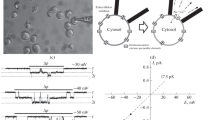Abstract
Permeable supports with A6 cell monolayers were mounted in an Ussing chamber and bilaterally bathed with Ringer solution at room temperature. Short-circuit current (I sc) was recorded continuously, and noise analysis revealed microscopic channel current characteristics. Our investigation focuses on the stimulation of apical Na+ entry caused by exposing the serosal surface of the A6 cell monolayers to hyposmotic Ringer solution. To evaluate the possible role of the cytoskeleton in the regulation of Na+ channels in response to a change in osmolality we used four different experimental approaches. In the control group, which were not exposed to any cytoskeleton-influencing drugs, there was a 1.5-fold increase in I sc and in the number of open Na+ channels after osmotic stimulation. For the second group cytochalasin D (0.1 µg/ml) was present on the serosal side during the experiments. Neither I sc nor the number of open Na+ channels increased after osmotic stimulation. In the third group colchicine (0.2 mM) or nocodazole (20 µM) was present on the serosal side, which resulted in 1.8-fold and 1.5-fold increases in I sc as well as 3-fold and 2-fold increases in the number of Na+ channels, respectively. In the fourth experimental group erythro-9-(2-hydroxy-3-nonyl) adenine hydrochloride (EHNA, 0.5 mM), a dynein inhibitor, was present on the serosal side. In this group I sc decreased to about 0.4 µA/cm2, and subsequent application of amiloride abolished I sc completely. Under hyposmolar conditions EHNA abolished entirely the sensitivity of I sc to the osmotic challenge. Because of the EHNA-induced down-regulation of I sc, the density of apical Na+ channels in this experimental group could not be determined. These results show that the cytoskeleton is dominantly involved in osmotic channel regulation at the apical membrane, and that actin filaments, microtubules and molecular motors are involved in the recruitment of additional Na+ channels.
Similar content being viewed by others
Author information
Authors and Affiliations
Additional information
Received: 21 July 1997 / Received after revision: 4 December 1997 / Accepted: 16 December 1997
Rights and permissions
About this article
Cite this article
Rehn, M., Weber, WM. & Clauss, W. Role of the cytoskeleton in stimulation of Na+ channels in A6 cells by changes in osmolality. Pflügers Arch 436, 270–279 (1998). https://doi.org/10.1007/PL00008083
Issue Date:
DOI: https://doi.org/10.1007/PL00008083




